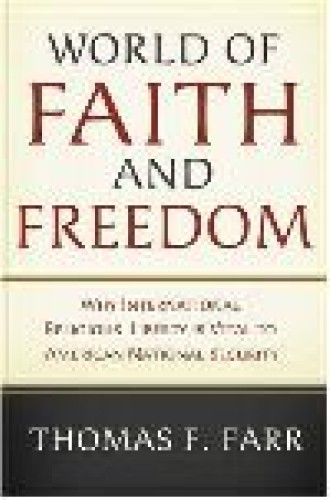World of Faith and Freedom: Why International Religious Liberty Is Vital to American National Security
President Barack Obama couldn’t have been more explicit in his inaugural address. Moments into his young presidency, the Democrat let Muslims know that he wants to work with them to bring stability to the world.
To achieve this, however, his foreign-policy team will need to understand what Muslims around the world want and think. And that won’t be simple because our foreign-policy establishment has never been comfortable with the subject of religion as a force that shapes events around the world.
Thomas Farr, who was the first head of the State Department’s Office of International Religious Freedom, argues compellingly in World of Faith and Freedom that his fellow career diplomats suffer from a “religion deficit.” He pre sents several reasons for their lack of understanding about how spiritual values shape the culture and politics of nations. Diplomats tend to prefer secularism and to see religion only as a marginal force, he explains, and foreign-service officers often think of religion simply in terms of constituent services, like the service of freeing someone in a foreign land from religious persecution.
Though Farr was a foreign-service officer for 21 years, he admits that he didn’t recognize the intersection of religion, politics and culture until 1999 when he went to work at the Office on International Religious Freedom, which had just been established by an act of Congress.
Farr now teaches at Georgetown University’s School of Foreign Service and is a senior fellow at the Berkley Center for Religion, Peace and World Affairs. Trained as a historian, he gets down into the weeds of internal State Department battles; readers could probably do with less score-settling and bureaucratic lingo.
Still, his thesis is valid—and important. Makers of U.S. foreign policy need to understand how religion shapes societies, or the U.S. will miss one of the world’s most powerful forces, just as it did when it failed to anticipate the depths of the Sunni-Shi‘a split that would make it difficult to unify Iraq after the invasion.
The big challenge for President Obama—and Secretary of State Hillary Clinton—will be getting diplomats down the chain of command to dig into what religious leaders are saying, writing and thinking in the countries the diplomats are serving—and into what people in churches, synagogues and mosques believe. This is necessary not so the U.S. or the host government can police their beliefs, but so decision makers in the U.S. can understand the trends at play abroad.
When diplomats do focus on religion, they often see its potential to generate conflict, particularly in the Middle East. However, Farr points out, religion has also contributed to social stability; it is often the glue that binds a society together.
The part of Farr’s book that I found most fascinating is his discussion of China, where religion is emerging as a powerful force. He writes about visiting with people who held a wide range of views, which the authorities didn’t always appreciate, and he offers strategies for dealing with China’s bias against religion.
The way Farr sees it, U.S. diplomats must keep speaking out against cases of religious discrimination in China, but a “medium- and long-term strategy of fundamentally altering China’s perception of religion” is also necessary. Instead of threatening sanctions whenever China starts persecuting people of faith, he says, the U.S. should explain to Chinese leaders why these same believers can help them grow their economy and stabilize their politics. Farr contends that religious communities especially can help China deal with its breakdown in family life, the rise of AIDS and the insufficiency of its social services. The U.S. has taken such a tack from time to time with China, but never consistently, and a consistent approach is what will get the attention of China’s leaders, claims Farr.
By leading off with one of the biggest diplomatic challenges his administration faces—improving relations in the Muslim world—Obama signaled that he understands religion’s influence. And Clinton’s deep roots in Methodism make me think that she does too. Over the next four years, they will need the wisdom of clergy, theologians and lay leaders of various faiths to help them—and to help U.S. diplomats—to deepen their understanding about religious trends around the world.
To avoid what Farr calls a “diplomacy of unreality,” the U.S. needs to know the religious realities on the ground. The U.S. missed those realities in Iraq and has missed them elsewhere as well over the years—as in Iran three decades ago when the U.S. failed to understand the rise of the Ayatollah Khomeini, partly because foreign-service officers lacked “mosque time,” as Farr puts it. No one wants colossal mistakes like these again. The U.S. national interest has a dog in this hunt.




